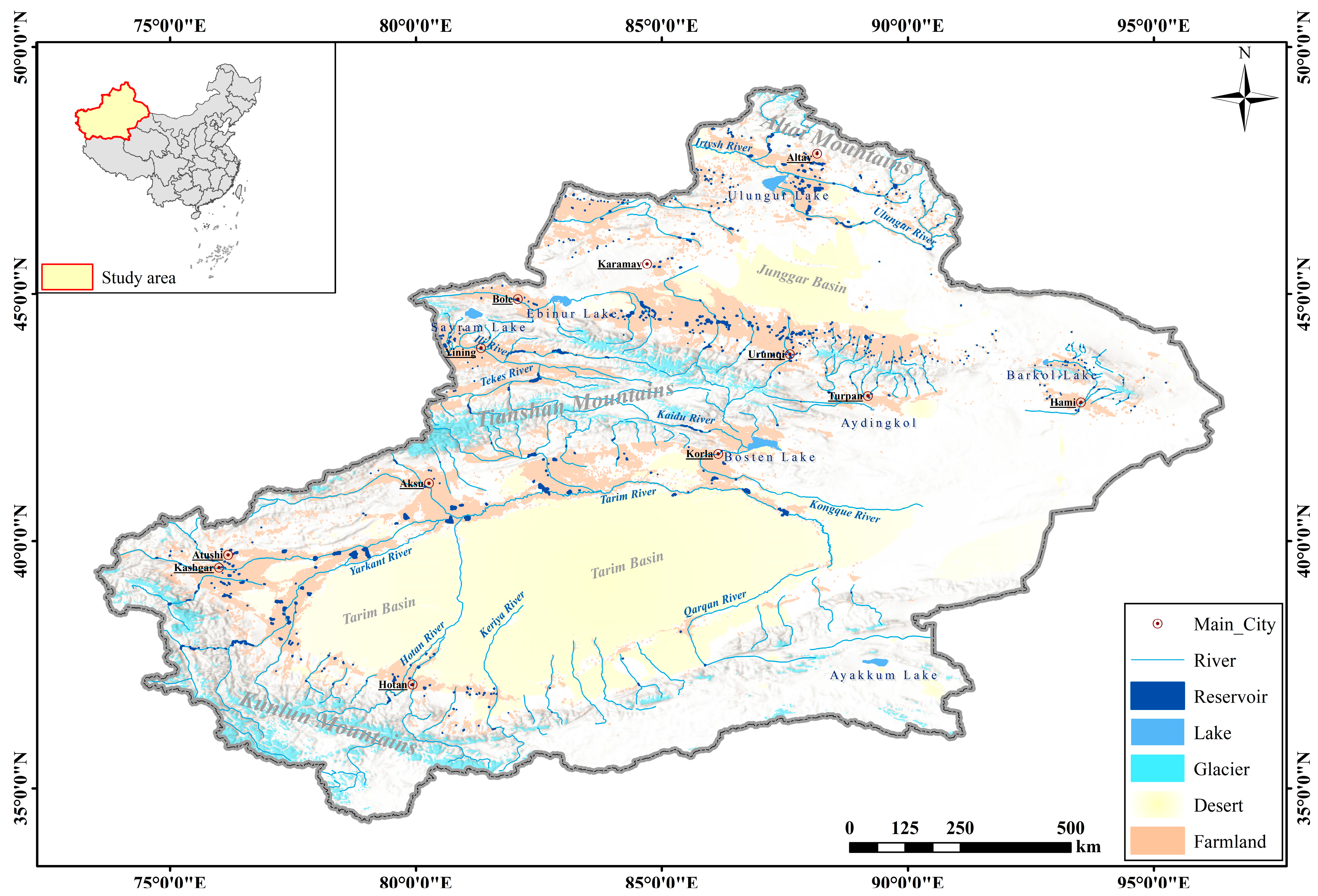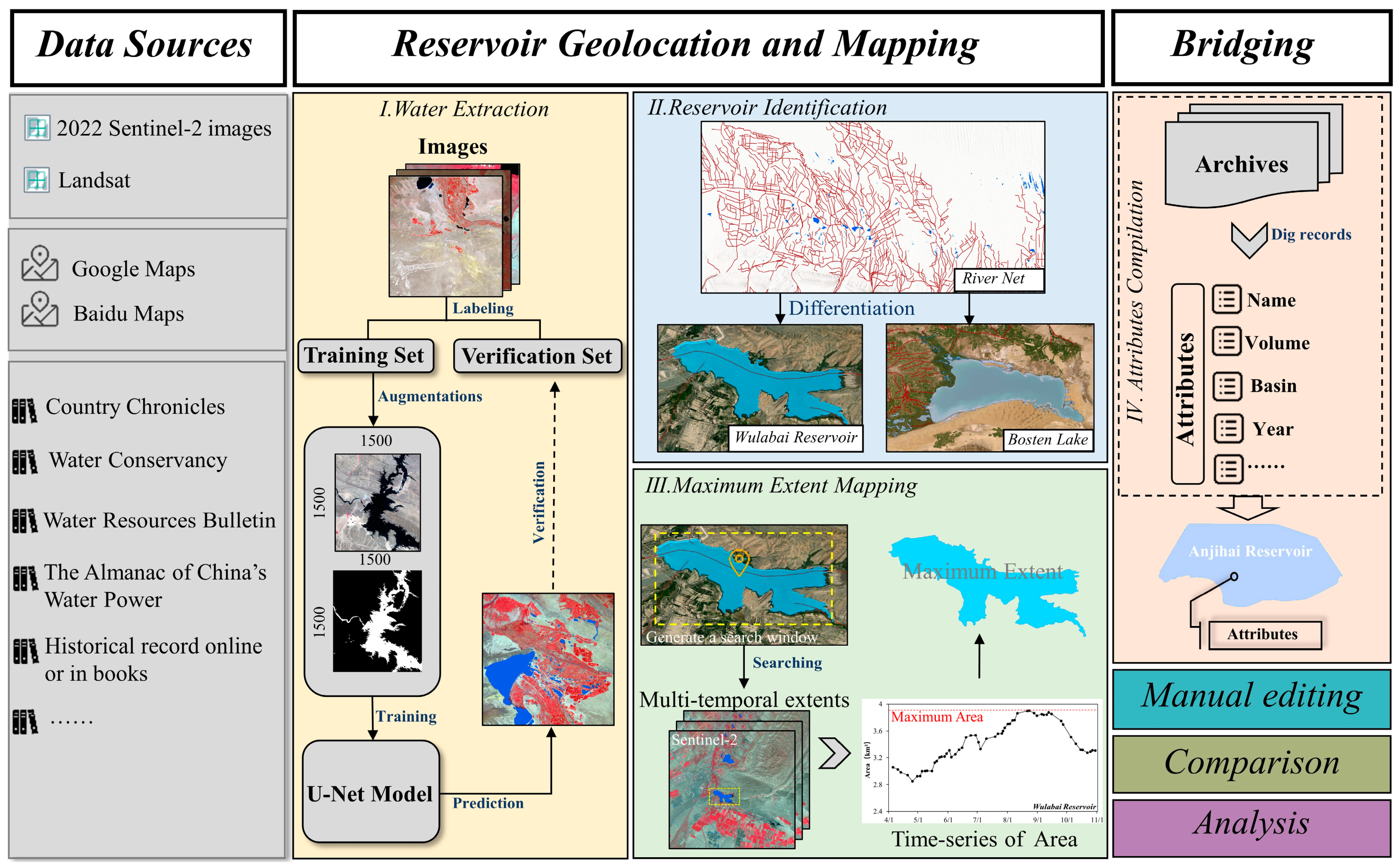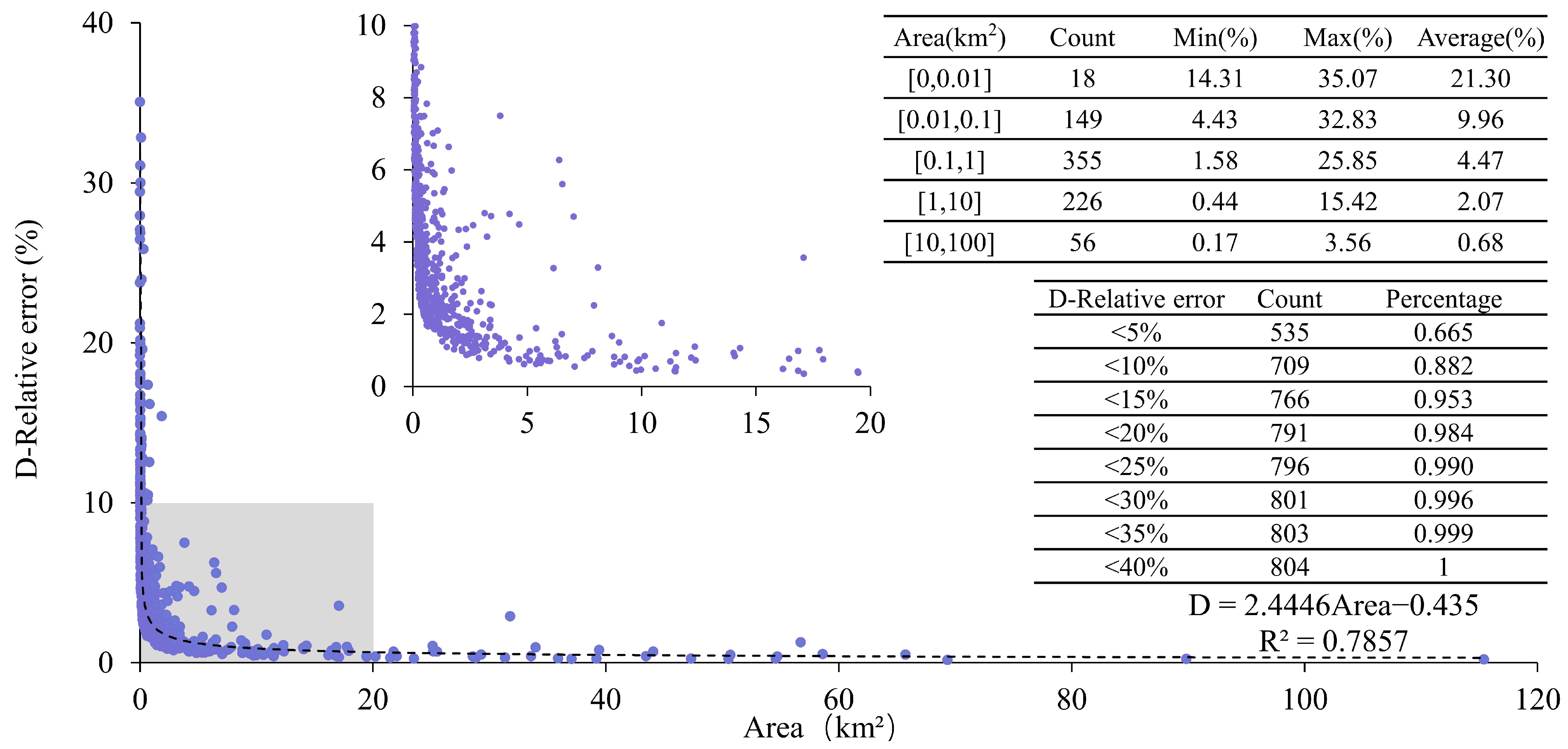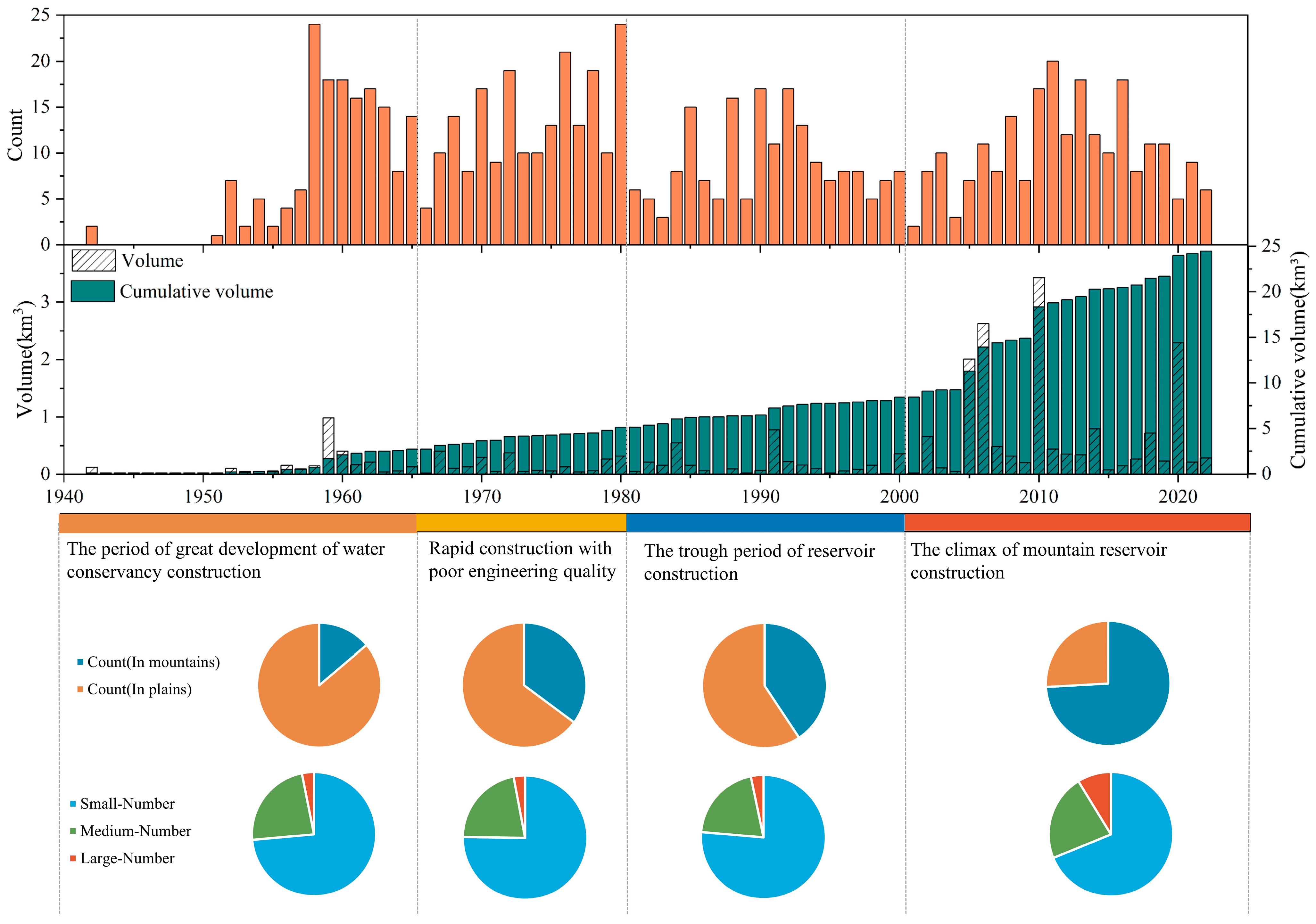Combining Satellite Images and the Hydraulic Engineering Archive to Map the Processes of Reservoir Construction in Xinjiang
Abstract
1. Introduction
2. Materials and Methods
2.1. Study Area
2.2. Data Sources
2.2.1. Sentinel-2
2.2.2. Landsat
2.2.3. Hydraulic Engineering Archive
2.3. Methodologies
2.3.1. Water Body Mapping via the U-Net Model
2.3.2. Reservoir Identification and Geolocation
2.3.3. Reservoir Maximum Area Mapping
2.3.4. Determining the Completion and Abandonment Years of Reservoirs
2.3.5. Bridging Attributes and Geolocation
3. Mapping Accuracies and Validations
3.1. Uncertainty Assessment of Reservoir Extent
3.2. Comparison with Existing Reservoir or Dam Databases
4. Results
4.1. Characteristics of Spatial Distribution
4.2. Characteristics of Altitudinal Distribution
4.3. Temporal Processes of Reservoir Construction
5. Discussion
5.1. Improvements in the Dataset of Reservoirs in Xinjiang
5.2. Reservoir Construction with Oasis Expansion and Ecological Protection
5.3. Uncertainty about the Capacity and Quantity of Reservoirs
6. Conclusions
Author Contributions
Funding
Data Availability Statement
Acknowledgments
Conflicts of Interest
References
- Dams, W.C.O. Dams and development a new framework for decision-making. Proc. Inst. Civ. Eng. Civ. Eng. 2001, 144, 8–9. [Google Scholar]
- Demirbas, A. Global Renewable Energy Projections. Energy Sources Part B Econ. Plan. Policy 2009, 4, 212–224. [Google Scholar] [CrossRef]
- Lehner, B.; Reidy Liermann, C.; Revenga, C.; Vorosmarty, C.; Fekete, B.; Crouzet, P.; Doll, P.; Endejan, M.; Frenken, K.; Magome, J.; et al. High-resolution mapping of the world’s reservoirs and dams for sustainable river-flow management. Front. Ecol. Environ. 2011, 9, 494–502. [Google Scholar] [CrossRef] [PubMed]
- Liu, B.; Yang, G.; He, X. Response of groundwater to the process of reservoirs group regulation and storage in Manas River Basin in Xinjiang. Int. J. Agric. Biol. Eng. 2020, 13, 224–233. [Google Scholar] [CrossRef]
- Haddeland, I.; Skaugen, T.; Lettenmaier, D.P. Anthropogenic impacts on continental surface water fluxes. Geophys. Res. Lett. 2006, 33, 26047. [Google Scholar] [CrossRef]
- Vogl, A.L.; Lopes, V.L. Impacts of water resources development on flow regimes in the Brazos River. Environ. Monit. Assess. 2009, 157, 331–345. [Google Scholar] [CrossRef] [PubMed]
- Kingsford, R.T. Ecological impacts and institutional and economic drivers for water resource development—A case study of the Murrumbidgee River, Australia. Aquat. Ecosyst. Health Manag. 2003, 6, 69–79. [Google Scholar] [CrossRef]
- Kingsford, R.T.; Thomas, R.F. Destruction of Wetlands and Waterbird Populations by Dams and Irrigation on the Murrumbidgee River in Arid Australia. Environ. Manag. 2004, 34, 383–396. [Google Scholar] [CrossRef]
- Grill, G.; Lehner, B.; Thieme, M.; Geenen, B.; Tickner, D.; Antonelli, F.; Babu, S.; Borrelli, P.; Cheng, L.; Crochetiere, H.; et al. Mapping the world’s free-flowing rivers. Nature 2019, 569, 215–221. [Google Scholar] [CrossRef]
- Wang, B.; Zhang, H.; Liang, X.; Li, X.; Wang, F. Cumulative effects of cascade dams on river water cycle: Evidence from hydrogen and oxygen isotopes. J. Hydrol. 2019, 568, 604–610. [Google Scholar] [CrossRef]
- Annys, S.; Ghebreyohannes, T.; Nyssen, J. Impact of Hydropower Dam Operation and Management on Downstream Hydrogeomorphology in Semi-Arid Environments (Tekeze, Northern Ethiopia). Water 2020, 12, 2237. [Google Scholar] [CrossRef]
- Sang, L.; Zhu, G.; Xu, Y.; Sun, Z.; Zhang, Z.; Tong, H. Effects of Agricultural Large-And Medium-Sized Reservoirs on Hydrologic Processes in the Arid Shiyang River Basin, Northwest China. Water Resour. Res. 2023, 59, e2022WR033519. [Google Scholar] [CrossRef]
- Taleb, A.; Belaidi, N.; Gagneur, J. Water quality before and after dam building on a heavily polluted river in semi-arid Algeria. River Res. Appl. 2004, 20, 943–956. [Google Scholar] [CrossRef]
- Ablat, X.; Wang, Q.; Arkin, N.; Guoping, T.; Sawut, R. Spatiotemporal variations and underlying mechanism of the floodplain wetlands in the meandering Yellow River in arid and semi-arid regions. Ecol. Indic. 2022, 136, 108709. [Google Scholar] [CrossRef]
- Yi, Y.; Zhou, Y.; Song, J.; Zhang, S.; Cai, Y.; Yang, W.; Yang, Z. The effects of cascade dam construction and operation on riparian vegetation. Adv. Water Resour. 2019, 131, 103206. [Google Scholar] [CrossRef]
- Tao, H.; Gemmer, M.; Bai, Y.; Su, B.; Mao, W. Trends of streamflow in the Tarim River Basin during the past 50years: Human impact or climate change? J. Hydrol. 2011, 400, 1–9. [Google Scholar] [CrossRef]
- Soesbergen, A.V.; Chu, Z.; Shi, M.; Mulligan, M. Dam Reservoir Extraction From Remote Sensing Imagery Using Tailored Metric Learning Strategies. IEEE Trans. Geosci. Remote Sens. 2022, 60, 4207414. [Google Scholar] [CrossRef]
- Mulligan, M.; van Soesbergen, A.; Sáenz, L. GOODD, a global dataset of more than 38,000 georeferenced dams. Sci. Data 2020, 7, 31. [Google Scholar] [CrossRef]
- Donchyts, G.; Winsemius, H.; Baart, F.; Dahm, R.; Schellekens, J.; Gorelick, N.; Iceland, C.; Schmeier, S. High-resolution surface water dynamics in Earth’s small and medium-sized reservoirs. Sci. Rep. 2022, 12, 13776. [Google Scholar] [CrossRef]
- Khandelwal, A.; Karpatne, A.; Ravirathinam, P.; Ghosh, R.; Wei, Z.; Dugan, H.A.; Hanson, P.C.; Kumar, V. ReaLSAT, a global dataset of reservoir and lake surface area variations. Sci. Data 2022, 9, 356. [Google Scholar] [CrossRef]
- Song, C.; Fan, C.; Zhu, J.; Wang, J.; Sheng, Y.; Liu, K.; Chen, T.; Zhan, P.; Luo, S.; Yuan, C.; et al. A comprehensive geospatial database of nearly 100 000 reservoirs in China. Earth Syst. Sci. Data 2022, 14, 4017–4034. [Google Scholar] [CrossRef]
- Wang, J.; Walter, B.A.; Yao, F.; Song, C.; Ding, M.; Maroof, A.S.; Zhu, J.; Fan, C.; McAlister, J.M.; Sikder, S.; et al. GeoDAR: Georeferenced global dams and reservoirs dataset for bridging attributes and geolocations. Earth Syst. Sci. Data 2022, 14, 1869–1899. [Google Scholar] [CrossRef]
- Zhang, A.T.; Gu, V.X. Global Dam Tracker: A database of more than 35,000 dams with location, catchment, and attribute information. Sci. Data 2023, 10, 111. [Google Scholar] [CrossRef] [PubMed]
- Zhang, B.; Li, J.; Shen, Q.; Wu, Y.; Zhang, F.; Wang, S.; Yao, Y.; Guo, L.; Yin, Z. Recent research progress on long time series and large scale optical remote sensing of inland water. J. Remote Sens. 2021, 25, 37–52. [Google Scholar] [CrossRef]
- Verpoorter, C.; Kutser, T.; Seekell, D.A.; Tranvik, L.J. A global inventory of lakes based on high-resolution satellite imagery. Geophys. Res. Lett. 2014, 41, 6396–6402. [Google Scholar] [CrossRef]
- Feng, M.; Sexton, J.O.; Channan, S.; Townshend, J.R. A global, high-resolution (30-m) inland water body dataset for 2000: First results of a topographic-spectral classification algorithm. Int. J. Digit. Earth 2016, 9, 113–133. [Google Scholar] [CrossRef]
- Pi, X.; Luo, Q.; Feng, L.; Xu, Y.; Tang, J.; Liang, X.; Ma, E.; Cheng, R.; Fensholt, R.; Brandt, M.; et al. Mapping global lake dynamics reveals the emerging roles of small lakes. Nat. Commun. 2022, 13, 5777. [Google Scholar] [CrossRef]
- Hou, J.; Van Dijk, A.I.J.M.; Renzullo, L.J.; Larraondo, P.R. GloLakes: A database of global lake water storage dynamics from 1984 to present derived using laser and radar altimetry and optical remote sensing. Earth Syst. Sci. Data Discuss. 2022, 201–208, in review. [Google Scholar] [CrossRef]
- Pekel, J.F.; Cottam, A.; Gorelick, N.; Belward, A.S. High-resolution mapping of global surface water and its long-term changes. Nature 2016, 540, 418–422. [Google Scholar] [CrossRef]
- Zhao, G.; Gao, H. Automatic Correction of Contaminated Images for Assessment of Reservoir Surface Area Dynamics. Geophys. Res. Lett. 2018, 45, 6092–6099. [Google Scholar] [CrossRef]
- Wang, J. Study on spatiotemporal characteristics of drought in Xinjiang based on Multi-Source Weighted-Ensemble Precipitation multi-source merged precipitation product. Arid Zone Res. 2022, 39, 1398–1409. [Google Scholar] [CrossRef]
- Water Resources Bulletin of Xinjiang Uygur Autonomous Region. Available online: http://slt.xinjiang.gov.cn/ (accessed on 11 September 2023).
- Ghansah, B.; Foster, T.; Higginbottom, T.P.; Adhikari, R.; Zwart, S.J. Monitoring spatial-temporal variations of surface areas of small reservoirs in Ghana’s Upper East Region using Sentinel-2 satellite imagery and machine learning. Phys. Chem. Earth Parts A/B/C 2022, 125, 103082. [Google Scholar] [CrossRef]
- Wang, S. Encyclopaedia of Xinjiang Rivers and Lakes; China Water & Power Press: Beijing, China, 2011. [Google Scholar]
- Li, X.; Hu, Z.; Qin, M. Urumqi River Basin Chronicle; Xinjiang People’s Publishing House: Urumqi, China, 2000. [Google Scholar]
- Wang, Y.; Cui, Z.; Wang, F. Aksu River Basin Chronicles; China Local Records Publishing House: Beijing, China, 2006. [Google Scholar]
- Li, J. Yarkant River Basin Chronicle; Xinjiang People’s Publishing House: Urumqi, China, 2008. [Google Scholar]
- Li, Z.; Demir, I. U-net-based semantic classification for flood extent extraction using SAR imagery and GEE platform: A case study for 2019 central US flooding. Sci. Total Environ. 2023, 869, 161757. [Google Scholar] [CrossRef] [PubMed]
- Zhao, X.; Wang, H.; Liu, L.; Zhang, Y.; Liu, J.; Qu, T.; Tian, H.; Lu, Y. A Method for Extracting Lake Water Using ViTenc-UNet: Taking Typical Lakes on the Qinghai-Tibet Plateau as Examples. Remote Sens. 2023, 15, 4047. [Google Scholar] [CrossRef]
- Ronneberger, O.; Fischer, P.; Brox, T. U-Net: Convolutional Networks for Biomedical Image Segmentation. In Proceedings of the Medical Image Computing and Computer-Assisted Intervention—MICCAI 2015, Cham, Switzerland, 5–9 October 2015; pp. 234–241. [Google Scholar]
- Wang, N.; Cheng, J.; Zhang, H.; Cao, H.; Liu, J. Application of U-net model to water extraction with high resolution remote sensing data. Remote Sens. Land Resour. 2020, 32, 35–42. [Google Scholar]
- Shi, J.; Shen, Q.; Peng, H.; Li, L.; Yao, Y.; Wang, M.; Wang, R. Research on Urban Water Body Extraction based on Transfer Learning of Three High-resolution Image Datasets. Remote Sens. Technol. Appl. 2022, 37, 731–738. [Google Scholar]
- Lin, T.; Goyal, P.; Girshick, R.; He, K.; Dollár, P. Focal Loss for Dense Object Detection. In Proceedings of the 2017 IEEE International Conference on Computer Vision (ICCV), Venice, Italy, 22–29 October 2017; pp. 2999–3007. [Google Scholar]
- Kalinaki, K.; Malik, O.A.; Ching Lai, D.T. FCD-AttResU-Net: An improved forest change detection in Sentinel-2 satellite images using attention residual U-Net. Int. J. Appl. Earth Obs. Geoinf. 2023, 122, 103453. [Google Scholar] [CrossRef]
- Lehner, B.; Grill, G. Global river hydrography and network routing: Baseline data and new approaches to study the world’s large river systems. Hydrol. Process. 2013, 27, 2171–2186. [Google Scholar] [CrossRef]
- Wang, X.; Xiao, X.; Qin, Y.; Dong, J.; Wu, J.; Li, B. Improved maps of surface water bodies, large dams, reservoirs, and lakes in China. Earth Syst. Sci. Data 2022, 14, 3757–3771. [Google Scholar] [CrossRef]
- van Bemmelen, C.W.T.; Mann, M.; de Ridder, M.P.; Rutten, M.M.; van de Giesen, N.C. Determining water reservoir characteristics with global elevation data. Geophys. Res. Lett. 2016, 43, 11278–11286. [Google Scholar] [CrossRef]
- Zhang, F.; Cui, N.; Guo, S.; Yue, Q.; Jiang, S.; Zhu, B.; Yu, X. Irrigation strategy optimization in irrigation districts with seasonal agricultural drought in southwest China: A copula-based stochastic multiobjective approach. Agric. Water Manag. 2023, 282, 108293. [Google Scholar] [CrossRef]
- Nam, W.-H.; Kim, T.; Hong, E.-M.; Choi, J.-Y. Regional Climate Change Impacts on Irrigation Vulnerable Season Shifts in Agricultural Water Availability for South Korea. Water 2017, 9, 735. [Google Scholar] [CrossRef]
- Dinh, H.X.; Hoang, T.T.; Ha, L.T.; Nguyen, T.V.; Pham, T.C.; Nguyen, M.C.; Luong, H.T. Remote Sensing-Based Accounting of Reservoir’s Water Storage for Water Scarcity Mitigation: A Case Study for Small and Medium Irrigation Dams in Vietnam. J. Geosci. Environ. Prot. 2021, 9, 89–97. [Google Scholar] [CrossRef]
- Nan, X.; Li, A.; Deng, W. Data Set of “Digital Mountain Map of China” (2015); A Big Earth Data Platform for Three Poles; National Tibetan Plateau/Third Pole Environment Data Center: Beijing, China, 2022. [Google Scholar] [CrossRef]
- Hanshaw, M.N.; Bookhagen, B. Glacial areas, lake areas, and snow lines from 1975 to 2012: Status of the Cordillera Vilcanota, including the Quelccaya Ice Cap, northern central Andes, Peru. Cryosphere 2014, 8, 359–376. [Google Scholar] [CrossRef]
- Lyons, E.A.; Sheng, Y.; Smith, L.C.; Li, J.; Hinkel, K.M.; Lenters, J.D.; Wang, J. Quantifying sources of error in multitemporal multisensor lake mapping. Int. J. Remote Sens. 2013, 34, 7887–7905. [Google Scholar] [CrossRef]
- Gu, X.; Li, M.; Xu, D.; Zhang, B.; Nie, X.; Wang, S.; Zhang, Z.; Liu, Q.; Li, J.; Huang, W.; et al. Report on Remote Sensing Monitoring of China Sustainable Development (2019); Social Sciences Academic Press: Beijing, China, 2020. [Google Scholar]
- Li, J.; Liu, Y.; Peng, Z.; Yang, Y. Characteristics and construction managementideas of reservoir dams in Xinjiang. China Water Resour. 2023, 16, 41–46. [Google Scholar]
- Standard for Rank Classification and Flood Protection Criteria of Water and Hydropower Projects; China Water&Power Press: Beijing, China, 2017.
- Liu, K.; Song, C.Q.; Wang, J.D.; Ke, L.H.; Zhu, Y.Q.; Zhu, J.Y.; Ma, R.H.; Luo, Z. Remote Sensing-Based Modeling of the Bathymetry and Water Storage for Channel-Type Reservoirs Worldwide. Water Resour. Res. 2020, 56, e2020WR027147. [Google Scholar] [CrossRef]
- Weekley, D.; Li, X.G. Tracking Multidecadal Lake Water Dynamics with Landsat Imagery and Topography/Bathymetry. Water Resour. Res. 2019, 55, 8350–8367. [Google Scholar] [CrossRef]








| Name | Source | Time Periods | Numbers of Reservoirs | Attributes |
|---|---|---|---|---|
| County Chronicles | https://fz.wanfangdata.com.cn/, accessed on 7 August 2023 | 1950–2010 | 427 | name, location, volume, completion year, function type, dam type, dam height |
| Municipal chronicles | 1950–2007 | 515 | name, location, volume, completion year, function type, dam type, dam height | |
| River Basin Chronicles [35,36,37] | 1950–2000 | 47 | name, location, volume, completion year | |
| General Chronicle of Xinjiang: Water Conservancy Chronicle | 1950–1985 | 485 | name, location, volume, completion year, dam type, irrigation area | |
| The Archives of Hydraulic and Hydropower Engineering | http://slt.xinjiang.gov.cn/, accessed on 7 August 2023 | 1950–2018 | 589 | name, volume, completion year |
| Encyclopedia of Xinjiang Rivers and Lakes | [34] | 1950–1995 | 368 | name, location, volume, completion year, dam type |
| Attribute | Description |
|---|---|
| R_ID | Means the identified ID for each reservoir. |
| Name | Indicates the name of the reservoir. |
| Lat | Latitude of the center point of the reservoir (World Geodetic System (WGS) 1984, unit—° |
| Long | Longitude of the center point of the reservoir (WGS 1984, unit—°) |
| Altitude | The average altitude of the reservoir (unit in m) |
| MaxArea | The maximum water area of the reservoir (unit in km2) |
| Volume | The total storage capacity of values from the yearbooks and literature records (unit in km3). |
| Re_Types | The reservoir type is defined by its ecoregion (mountainous or plain reservoirs). |
| YearBuilt | Indicates the year of reservoir completion. |
| Y_Abandon | Indicates the year of reservoir abandonment. |
| Admin | Indicates the county where the reservoir is located. |
| River | Indicates the river to which the reservoir belongs. |
| Dataset | Production Time | Domain | Data Source and Spatial Resolution | Count * | Total Volume(km3) * | Minimum Reservoir Area (km2) * | Crucial Attributes * |
|---|---|---|---|---|---|---|---|
| GeoDAR [22] | 2022 | Global | / | 16 | 9.17 | 0.094 | coordinate, area, capacity, reference data sources |
| GLAKES [27] | 2022 | Global | 30 m, Landsat | 626 (19) | / | 0.062 | coordinate, area, water source, type |
| CRD [21] | 2022 | China | / | 673 | 30.41 | 0.005 | name, coordinate, prefecture, county, area, storage, type, shape, length |
| China Reservoirs [54] | 2019 | Xinjiang | 30 m, Landsat | 731 | / | / | distribution, total area |
| Xinjiang Reservoirs [55] | 2022 | Xinjiang | / | 751 | 29.78 | / | distribution, total capacity |
| XJR | 2022 | Xinjiang | 10 m, Sentinel-2 | 804 | 24.58 | 0.003 | name, coordinate, shape length, volume, area, altitude, type, built year, admin, river |
| Construction Period | Numbers | Capacities km3 | Counted by Terrain | Counted by Size | |||
|---|---|---|---|---|---|---|---|
| Mountains | Plains | Small | Medium | Large | |||
| 1940–1965 | 159 | 2.71 | 22 | 137 | 117 | 37 | 5 |
| 1966–1980 | 202 | 2.38 | 71 | 131 | 152 | 44 | 6 |
| 1981–2000 | 182 | 3.33 | 74 | 108 | 139 | 37 | 6 |
| 2001–2030 | 228 | 16.06 | 169 | 59 | 157 | 51 | 20 |
Disclaimer/Publisher’s Note: The statements, opinions and data contained in all publications are solely those of the individual author(s) and contributor(s) and not of MDPI and/or the editor(s). MDPI and/or the editor(s) disclaim responsibility for any injury to people or property resulting from any ideas, methods, instructions or products referred to in the content. |
© 2024 by the authors. Licensee MDPI, Basel, Switzerland. This article is an open access article distributed under the terms and conditions of the Creative Commons Attribution (CC BY) license (https://creativecommons.org/licenses/by/4.0/).
Share and Cite
Li, S.; Li, J.; Du, W.; Liu, S.; Wang, H.; Jin, J. Combining Satellite Images and the Hydraulic Engineering Archive to Map the Processes of Reservoir Construction in Xinjiang. Remote Sens. 2024, 16, 328. https://doi.org/10.3390/rs16020328
Li S, Li J, Du W, Liu S, Wang H, Jin J. Combining Satellite Images and the Hydraulic Engineering Archive to Map the Processes of Reservoir Construction in Xinjiang. Remote Sensing. 2024; 16(2):328. https://doi.org/10.3390/rs16020328
Chicago/Turabian StyleLi, Shuangshuang, Junli Li, Weibing Du, Shuaiqi Liu, Haoyu Wang, and Jingyu Jin. 2024. "Combining Satellite Images and the Hydraulic Engineering Archive to Map the Processes of Reservoir Construction in Xinjiang" Remote Sensing 16, no. 2: 328. https://doi.org/10.3390/rs16020328
APA StyleLi, S., Li, J., Du, W., Liu, S., Wang, H., & Jin, J. (2024). Combining Satellite Images and the Hydraulic Engineering Archive to Map the Processes of Reservoir Construction in Xinjiang. Remote Sensing, 16(2), 328. https://doi.org/10.3390/rs16020328







